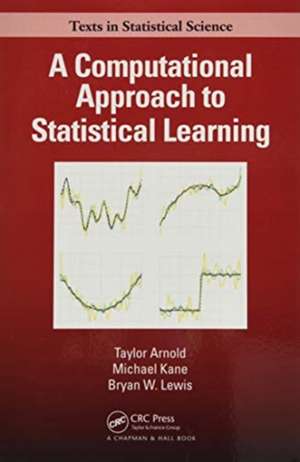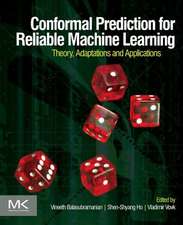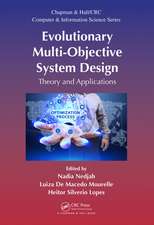A Computational Approach to Statistical Learning: Chapman & Hall/CRC Texts in Statistical Science
Autor Taylor Arnold, Michael Kane, Bryan W. Lewisen Limba Engleză Paperback – 30 iun 2020
The text begins with a detailed analysis of linear models and ordinary least squares. Subsequent chapters explore extensions such as ridge regression, generalized linear models, and additive models. The second half focuses on the use of general-purpose algorithms for convex optimization and their application to tasks in statistical learning. Models covered include the elastic net, dense neural networks, convolutional neural networks (CNNs), and spectral clustering. A unifying theme throughout the text is the use of optimization theory in the description of predictive models, with a particular focus on the singular value decomposition (SVD). Through this theme, the computational approach motivates and clarifies the relationships between various predictive models.
Taylor Arnold is an assistant professor of statistics at the University of Richmond. His work at the intersection of computer vision, natural language processing, and digital humanities has been supported by multiple grants from the National Endowment for the Humanities (NEH) and the American Council of Learned Societies (ACLS). His first book, Humanities Data in R, was published in 2015.
Michael Kane is an assistant professor of biostatistics at Yale University. He is the recipient of grants from the National Institutes of Health (NIH), DARPA, and the Bill and Melinda Gates Foundation. His R package bigmemory won the Chamber's prize for statistical software in 2010.
Bryan Lewis is an applied mathematician and author of many popular R packages, including irlba, doRedis, and threejs.
| Toate formatele și edițiile | Preț | Express |
|---|---|---|
| Paperback (1) | 376.19 lei 6-8 săpt. | |
| CRC Press – 30 iun 2020 | 376.19 lei 6-8 săpt. | |
| Hardback (1) | 712.10 lei 6-8 săpt. | |
| CRC Press – 29 ian 2019 | 712.10 lei 6-8 săpt. |
Din seria Chapman & Hall/CRC Texts in Statistical Science
- 5%
 Preț: 650.11 lei
Preț: 650.11 lei - 9%
 Preț: 579.76 lei
Preț: 579.76 lei - 8%
 Preț: 547.81 lei
Preț: 547.81 lei - 5%
 Preț: 838.33 lei
Preț: 838.33 lei - 9%
 Preț: 595.18 lei
Preț: 595.18 lei - 9%
 Preț: 623.03 lei
Preț: 623.03 lei - 8%
 Preț: 544.76 lei
Preț: 544.76 lei - 9%
 Preț: 641.61 lei
Preț: 641.61 lei - 8%
 Preț: 508.20 lei
Preț: 508.20 lei - 8%
 Preț: 551.99 lei
Preț: 551.99 lei - 9%
 Preț: 1115.11 lei
Preț: 1115.11 lei - 9%
 Preț: 641.93 lei
Preț: 641.93 lei -
 Preț: 341.43 lei
Preț: 341.43 lei - 8%
 Preț: 536.31 lei
Preț: 536.31 lei -
 Preț: 357.60 lei
Preț: 357.60 lei - 8%
 Preț: 444.54 lei
Preț: 444.54 lei - 9%
 Preț: 578.22 lei
Preț: 578.22 lei -
 Preț: 371.71 lei
Preț: 371.71 lei - 9%
 Preț: 806.41 lei
Preț: 806.41 lei - 9%
 Preț: 602.46 lei
Preț: 602.46 lei - 9%
 Preț: 593.61 lei
Preț: 593.61 lei - 9%
 Preț: 608.09 lei
Preț: 608.09 lei - 8%
 Preț: 496.58 lei
Preț: 496.58 lei - 9%
 Preț: 610.94 lei
Preț: 610.94 lei - 20%
 Preț: 541.42 lei
Preț: 541.42 lei -
 Preț: 355.66 lei
Preț: 355.66 lei - 8%
 Preț: 516.75 lei
Preț: 516.75 lei -
 Preț: 349.10 lei
Preț: 349.10 lei - 9%
 Preț: 568.64 lei
Preț: 568.64 lei - 8%
 Preț: 465.05 lei
Preț: 465.05 lei - 9%
 Preț: 580.81 lei
Preț: 580.81 lei - 9%
 Preț: 617.41 lei
Preț: 617.41 lei - 9%
 Preț: 595.91 lei
Preț: 595.91 lei -
 Preț: 388.08 lei
Preț: 388.08 lei -
 Preț: 356.64 lei
Preț: 356.64 lei - 8%
 Preț: 547.38 lei
Preț: 547.38 lei - 9%
 Preț: 599.19 lei
Preț: 599.19 lei -
 Preț: 316.73 lei
Preț: 316.73 lei - 9%
 Preț: 638.87 lei
Preț: 638.87 lei -
 Preț: 349.46 lei
Preț: 349.46 lei -
 Preț: 372.50 lei
Preț: 372.50 lei - 8%
 Preț: 439.81 lei
Preț: 439.81 lei - 11%
 Preț: 686.52 lei
Preț: 686.52 lei - 8%
 Preț: 510.14 lei
Preț: 510.14 lei - 8%
 Preț: 511.07 lei
Preț: 511.07 lei - 8%
 Preț: 563.73 lei
Preț: 563.73 lei - 18%
 Preț: 713.39 lei
Preț: 713.39 lei - 15%
 Preț: 684.84 lei
Preț: 684.84 lei - 22%
 Preț: 371.94 lei
Preț: 371.94 lei
Preț: 376.19 lei
Preț vechi: 470.24 lei
-20% Nou
Puncte Express: 564
Preț estimativ în valută:
71.99€ • 74.88$ • 59.43£
71.99€ • 74.88$ • 59.43£
Carte tipărită la comandă
Livrare economică 14-28 aprilie
Preluare comenzi: 021 569.72.76
Specificații
ISBN-13: 9780367570613
ISBN-10: 0367570610
Pagini: 374
Dimensiuni: 156 x 234 x 20 mm
Greutate: 0.53 kg
Ediția:1Adnotată
Editura: CRC Press
Colecția Chapman and Hall/CRC
Seria Chapman & Hall/CRC Texts in Statistical Science
ISBN-10: 0367570610
Pagini: 374
Dimensiuni: 156 x 234 x 20 mm
Greutate: 0.53 kg
Ediția:1Adnotată
Editura: CRC Press
Colecția Chapman and Hall/CRC
Seria Chapman & Hall/CRC Texts in Statistical Science
Cuprins
Matrix Methods. Direct solutions to linear systems. Iterative linear model solutions. Iteratively reweighted least squares. Blockwise techniques. Convex optimization. Quasi-Newton and gradient descent. Interior point method. Proximal algorithms. Coordinate descent. Active sets and path solutions. Other techniques. Expectation maximization. Model featurization. Neighborhood prediction. Spectral learning. Stochastic techniques.
Notă biografică
Taylor Arnold is an assistant professor of statistics at the University of Richmond. His work at the intersection of computer vision, natural language processing, and digital humanities has been supported by multiple grants from the National Endowment for the Humanities (NEH) and the American Council of Learned Societies (ACLS). His first book, Humanities Data in R, was published in 2015.
Michael Kane is an assistant professor of biostatistics at Yale University. He is the recipient of grants from the National Institutes of Health (NIH), DARPA, and the Bill and Melinda Gates Foundation. His R package bigmemory won the Chamber's prize for statistical software in 2010.
Bryan Lewis is an applied mathematician and author of many popular R packages, including irlba, doRedis, and threejs.
Michael Kane is an assistant professor of biostatistics at Yale University. He is the recipient of grants from the National Institutes of Health (NIH), DARPA, and the Bill and Melinda Gates Foundation. His R package bigmemory won the Chamber's prize for statistical software in 2010.
Bryan Lewis is an applied mathematician and author of many popular R packages, including irlba, doRedis, and threejs.
Recenzii
"As best as I can determine, ‘A Computational Approach to Statistical Learning’ (CASL) is unique among R books devoted to statistical learning and data science. Other popular texts…cover much of the same ground, and include extensive R code implementing statistical models. What makes CASL different is the unifying mathematical structure underlying the presentation and the focus on the computations themselves…CASL’s great strengths are the use linear algebra to provide a coherent, unifying mathematical framework for explaining a wide class of models, a lucid writing style that appeals to geometric intuition, clear explanations of many details that are mostly glossed over in more superficial treatments, the inclusion of historical references, and R code that is tightly integrated into the text. The R code is extensive, concise without being opaque, and in many cases, elegant. The code illustrates R’s advantages for developing statistical algorithms as well as its power to present versatile and compelling visualizations…CASL ought to appeal to anyone working in data science or machine learning seeking a sophisticated understanding of both the theoretical basis and efficient algorithms underlying a modern approach to computational statistics."
~Joe Rickert, RStudio
"The ‘literate programming’ style is my favorite part of this book (borrowing the term from Don Knuth). It would be well suited for an engineer seeking to understand the implementations and ideas behind these statistical models. Real code beats pseudocode, because one can easily tweak and experiment with it…The other part I especially like is the development of neural nets based on extending the models previously introduced in the text. This takes some of the mystery out of neural nets and makes them more accessible to a statistician studying them for the first time... I would happily buy this book for my own reference and self-study... I’m not aware of any books that are written at this level that combines the motivation, the mathematics and the code in such a nice way. If I ever happen to be teaching a course on this material, then I would definitely teach from this book."
~Clark Fitzgerald, University of California, Davis
"I think the book is quite clearly written and covers really important things to consider that can help optimize model building. The book does a really great job of following its theme throughout and explicitly mentioning why they are explaining something the way they explain it. Reading the book, it is clear they considered how all the parts the included (at least the chapters I read) fit into the broader scope of the book's goal."
~Justin Post, North Carolina State University
~Joe Rickert, RStudio
"The ‘literate programming’ style is my favorite part of this book (borrowing the term from Don Knuth). It would be well suited for an engineer seeking to understand the implementations and ideas behind these statistical models. Real code beats pseudocode, because one can easily tweak and experiment with it…The other part I especially like is the development of neural nets based on extending the models previously introduced in the text. This takes some of the mystery out of neural nets and makes them more accessible to a statistician studying them for the first time... I would happily buy this book for my own reference and self-study... I’m not aware of any books that are written at this level that combines the motivation, the mathematics and the code in such a nice way. If I ever happen to be teaching a course on this material, then I would definitely teach from this book."
~Clark Fitzgerald, University of California, Davis
"I think the book is quite clearly written and covers really important things to consider that can help optimize model building. The book does a really great job of following its theme throughout and explicitly mentioning why they are explaining something the way they explain it. Reading the book, it is clear they considered how all the parts the included (at least the chapters I read) fit into the broader scope of the book's goal."
~Justin Post, North Carolina State University
Descriere
This book synthesizes those techniques from numerical analysis, algorithms, data structures, and optimization theory mostcommonly employed in statistics and machine learning. We provide concrete applications of these methods by giving complete reference implementations for a large set of the most commonly used statistical estimators. The goal is





























